Our History
The Oldest Hat Retailer In The United States!
Henry The Hatter History
Detroit's Exclusive Hatter since 1893!
Established in 1893 by Detroit native Henry Komrofsky, Henry the Hatter first opened on Gratiot Ave. Komrofsky had worked for a number of years as a hatter at the John C. Hartz store before opening his own shop. As a businessman, Komrofsky was interested in many aspects of city life. Following in the footsteps of his father, a musician and teacher, Komrofsky played the drums in a band at the Temple Theater. He was a member of the Detroit School’s Board of Education, and served as the Boxing Commissioner.
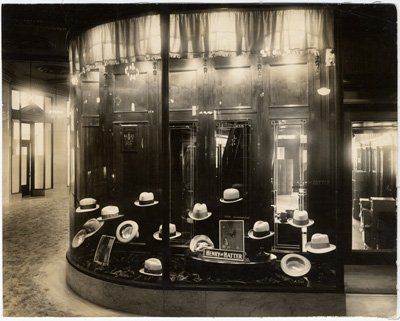
In 1904, Komrofsky hired a young stock & delivery boy named Gustave Newman, and in 1919 the two would run the hat store together as partners. Not long after Newman came on, Henry the Hatter moved to the Library Park Hotel Building, at Gratiot and Library streets. Henry The Hatter expanded in 1923 with a branch on Michigan Avenue in the Lafayette Building.
The Crowley Department Store began to build it's high rise structure in 1937, which forces Henry The Hatter to move across the street to 217 Gratiot Avenue.
When Komrofsky died in 1941, Newman continued to run the men’s hat store. But by the late 1940’s he was ready to retire and he put the business up for sale.
The buyer was Seymour Wasserman. A native New Yorker, Wasserman worked in his uncle’s hat factory until he bought his first hat store in New York in 1939.
Wasserman’s friend and partner Murray Appleby, a traveling hat salesman, heard that a hat store in Detroit was for sale. The two purchased Henry the Hatter in 1948. Wasserman relocated his family to Detroit, and a few years later, bought out Appleby.
In 1952, the Gratiot Ave. store was demolished and Henry The Hatter moved into the building they currently occupy at 1307 Broadway in Detroit.
The Michigan Ave. store closed in 1960, but was quickly relocated to 1126 Griswold in 1961. The Broadway Store was completely destroyed by a fire in 1962, but reopened in its same location four months later. In 1966 the Griswold store lost its lease and closed.
Paul Wasserman, who had joined his father in the hat business in 1973, remains as its owner today Seymour Wasserman passed away in 1998 at the age of 83.
Henry the Hatter has been able to maintain its downtown Detroit presence, and continue increasing sales by opening 2 other locations. In 1985 the Wasserman’s took over a hat store at 9307 Jos. Campau Street, in Hamtramck, MI. This location has been a retail hat store since 1919, starting as Joseph Polczinski Hats, and then inherited by his son in-law and changed to the Mroz Hat Shop. In 1991, the Wasserman’s opened a third Henry The Hatter retail hat store at the New Orleans Mall, located at 15616 W. 10 Mile road in Southfield, MI. In 2009, after 24 years the Hamtramck store closed due to declining business.
Recent Events of our Long History
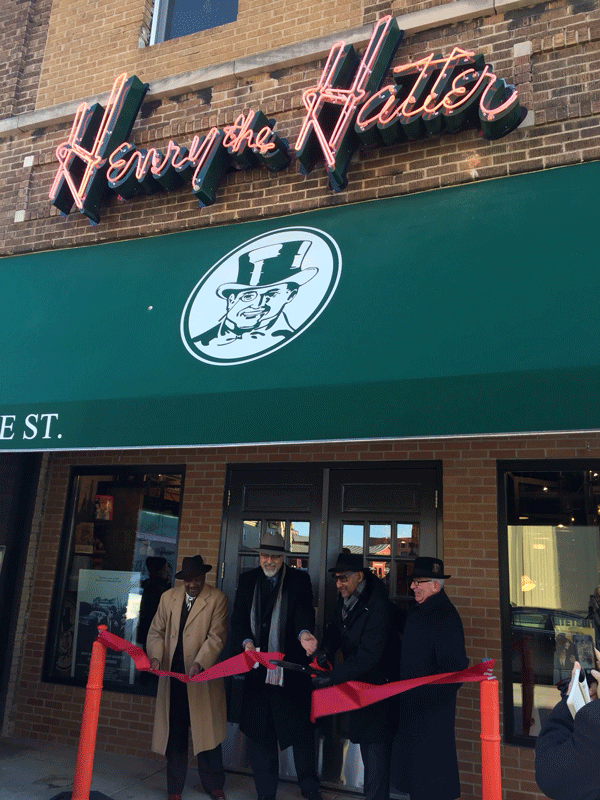
On August 5th, 2017, Henry The Hatter was not offered a new lease, and was forced to close its store on Broadway Ave after 65 years in this location.
News of the closure was a blow to our customers who have visited this location with their fathers and grandfathers, and they showed their love of Henry The Hatter with a great going away reception.
Mr. Wasserman, now 70 years of age could have walked away and sold the Southfield location, but with the insistence of his business successor Joe Renkiewicz, used his business contacts to find a new location in Detroit.
On December 8, 2017, Henry The Hatter opened a new store at 2472 Riopelle Street, in Detroit’s Historic Eastern Market!
Henry the Hatter received a big boost in the 1950’s when president Dwight D. Eisenhower wore a hat from this store to his inauguration; it was a homburg, rather than the traditional silk top hat, to reflect the need for austerity in the federal government.
When men stopped buying hats in the 1960’s, Henry the Hatter took to repairing and renovating those that their customers already owned. Henry the Hatter was actually a hat factory until 1985. When you came into Henry the Hatter at that time, if you didn’t see a hat on the shelf that caught your eye, a quick call was made upstairs where the hat finishing was done. You selected the felt finish, the brim size and finish, and what trimmings you wanted on your hat. Within a couple of hours your custom hat was ready.
Some folks try to blame the decline in hat wearing on President John F. Kennedy, who didn’t wear a hat to his inauguration. But Wasserman reminds us that the times, not the man, created the decline in hat wearing.
In the 1960’s we saw a lot of things changing. The perceived need for headwear as a protection from the elements declined, as the automobile industry flourished, and more people started driving to their destinations. It was no longer necessary to wait outside for a train, bus or streetcar.
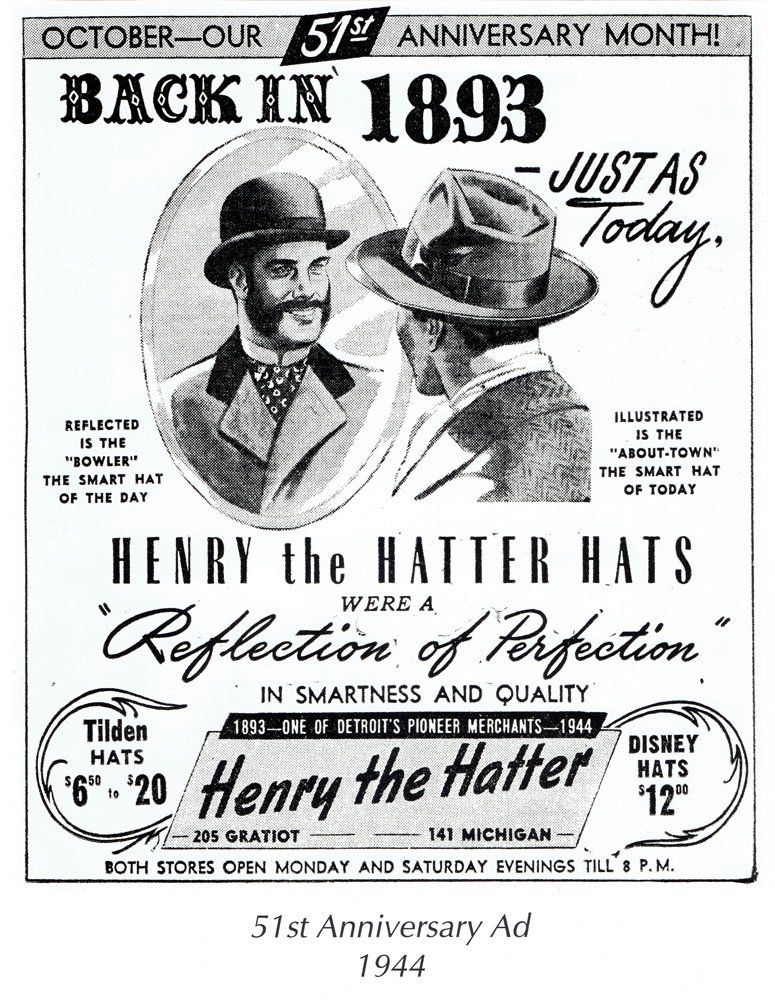
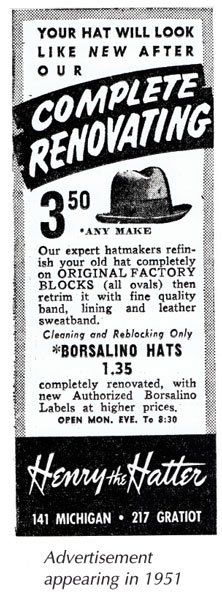
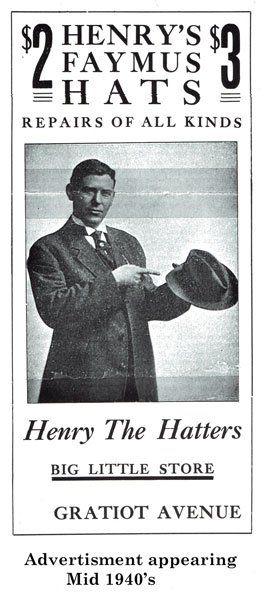
The utilitarian role of hats – warmth – is all but gone. But the role of hats in fashion and popular culture remains.
When Indiana Jones and “The Raiders of the Lost Ark” spawned an infatuation with down-turned brim fedoras, Henry the Hatter offered them in every material and price range. When Run-DMC and L.L. Cool J had rap fans searching for Kangol hats & caps, Henry The Hatter carried an enormous selection. And still today, the likes of Kid Rock and Steve Harvey still contact Henry The Hatter for their own hats.
Henry The Hatter has survived because it has embraced its customers and has adapted to their needs. The highly trained salespeople use their fashion sense to assist customers with selections that flatter not only the customers wardrobe, but they also take into account the style of each hat or cap, to accentuate the customers face and other features.
Over the last twenty years many of the changes that we have made in society and technology have also provided the means to make people think that hat wearing is no more then a fashion statement. But with doctors proving that over 75% of the body’s heat is lost through the head, and the recent backing of the American Association of Dermatology, and the Skin Cancer Foundation, showing that wearing a hat is a form of protection from the sun, you can see the continued benefits of wearing hats.
Henry the Hatter has been recognized by the Historical Society of Michigan as a Michigan Centennial Business, and has had the honor of twice being named “Hat Retailer of the Year” , Seymour Wasserman in 1977, and Paul Wasserman in 2000, by the Traveling Hat Salesmen Association Of America.
Information Provided by:
The Detroit News, The Detroit Jewish News, and Crain’s Detroit Business.
